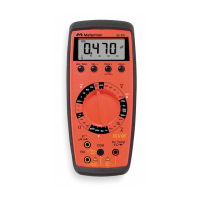3
Introduction
The 33XR is a manual ranging handheld digital multimeter for measuring or testing
the following:
• DC and AC voltage • Temperature
• DC and AC current • Capacitance
• Resistance • Diodes
• Frequency • Continuity
Additional features include the following modes:
MIN MAX, HOLD, REL (relative), and Peak±
Making Measurements
Verify Instrument Operation
Before attempting to make a measurement, verify that the instrument is operational
and the battery is good. If the instrument is not operational, have it repaired before
attempting to make a measurement.
Correcting an Overload (
o
) Indication
W
An
o
indication may appear on the display to indicate that an overload condition
exists. For voltage and current measurements, an overload should be immediately
corrected by selecting a higher range. If the highest range setting does not
eliminate the overload, interrupt the measurement until the problem is identified
and eliminated. The
o
indication is normal for some functions; for example,
resistance, continuity, and diode test.
Measuring DC Voltage See Figure -1-
1. Set the Range Switch to an appropriate
v
range.
Select the highest range and work down if the voltage level is unknown.
2. Connect the Test Leads: Red to
E
, Black to COM
3. Connect the Test Probes to the circuit test points.
4. Read the display, and, if necessary, fix any overload (
o
) conditions.
Measuring AC Voltage See Figure -2-
1. Set the Range Switch to an appropriate
V
range.
Select the highest range and work down if the voltage level is unknown.
2. Connect the Test Leads: Red to
E
, Black to COM
3. Connect the Test Probes to the circuit test points
4. Read the display, and, if necessary, fix any overload (
o
) conditions.
Preparing for Current Measurements
• Turn off circuit power before connecting the test probes.
• Allow the meter to cool between measurements if current measurements
approach or exceeds 10 amps.
• A warning tone sounds if you connect a test lead to a current input before you
select a current range.
• Open circuit voltage at the measurement point must not exceed 1000 V.
• Always measure current in series with the load. Never measure current across a
voltage source.

